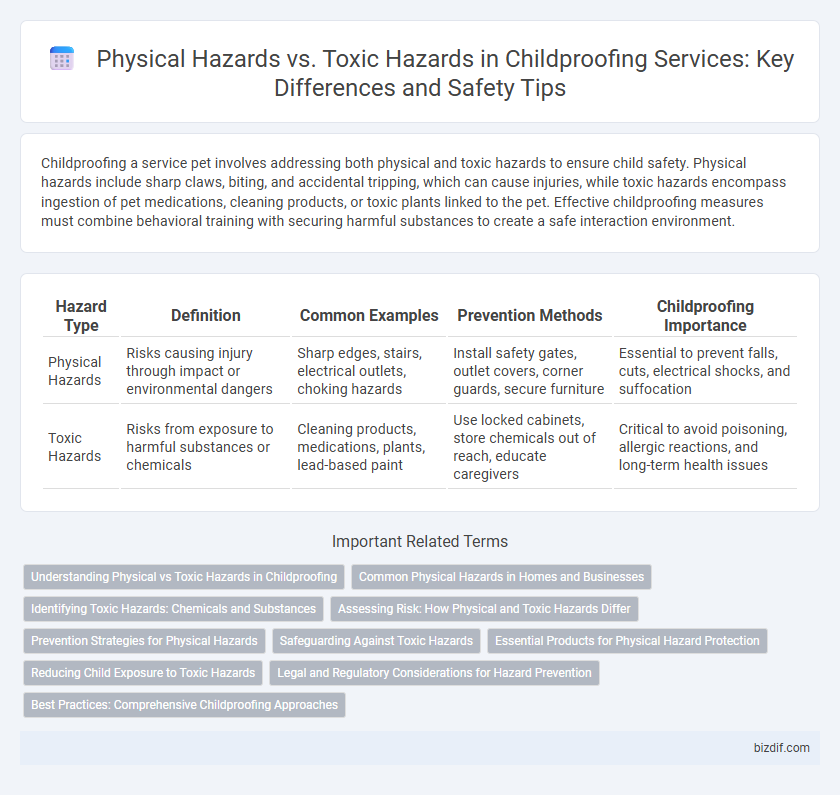Childproofing a service pet involves addressing both physical and toxic hazards to ensure child safety. Physical hazards include sharp claws, biting, and accidental tripping, which can cause injuries, while toxic hazards encompass ingestion of pet medications, cleaning products, or toxic plants linked to the pet. Effective childproofing measures must combine behavioral training with securing harmful substances to create a safe interaction environment.
Table of Comparison
| Hazard Type | Definition | Common Examples | Prevention Methods | Childproofing Importance |
|---|---|---|---|---|
| Physical Hazards | Risks causing injury through impact or environmental dangers | Sharp edges, stairs, electrical outlets, choking hazards | Install safety gates, outlet covers, corner guards, secure furniture | Essential to prevent falls, cuts, electrical shocks, and suffocation |
| Toxic Hazards | Risks from exposure to harmful substances or chemicals | Cleaning products, medications, plants, lead-based paint | Use locked cabinets, store chemicals out of reach, educate caregivers | Critical to avoid poisoning, allergic reactions, and long-term health issues |
Understanding Physical vs Toxic Hazards in Childproofing
Physical hazards in childproofing include sharp edges, small objects, and unstable furniture that can cause injuries or choking, while toxic hazards involve exposure to harmful chemicals, medications, and cleaning products. Effective childproofing requires identifying and mitigating these distinct risks by using safety gates, corner protectors, and secure storage for hazardous substances. Prioritizing both physical and toxic hazard prevention ensures a safe environment that reduces the risk of accidents and poisoning in children.
Common Physical Hazards in Homes and Businesses
Common physical hazards in homes and businesses include sharp edges, electrical outlets, unsecured furniture, and slippery floors, all posing significant injury risks to children. These dangers often result in cuts, falls, and electric shocks, making effective childproofing essential. Implementing safety measures like outlet covers, corner guards, and non-slip mats drastically reduces accidents and creates a safer environment for children.
Identifying Toxic Hazards: Chemicals and Substances
Identifying toxic hazards in childproofing involves recognizing common household chemicals such as cleaning agents, pesticides, and medications that pose poisoning risks to children. Effective childproofing includes securely storing these substances in locked cabinets or using safety containers to prevent accidental ingestion. Awareness of product labels and maintaining proper ventilation further reduces exposure to harmful toxins in the home environment.
Assessing Risk: How Physical and Toxic Hazards Differ
Physical hazards in childproofing involve risks like sharp edges, unstable furniture, and accessible electrical outlets, which pose immediate injury threats. Toxic hazards center on the presence of harmful substances such as cleaning chemicals, medications, and lead-based paints that can cause poisoning or long-term health issues. Assessing risk requires identifying the likelihood and severity of harm from both hazard types to implement targeted prevention strategies effectively.
Prevention Strategies for Physical Hazards
Preventing physical hazards in childproofing involves securing sharp edges, installing safety gates, and anchoring heavy furniture to prevent tipping. Using outlet covers and locking cabinets reduce access to dangerous areas, minimizing risks of falls or injuries. Regularly inspecting toys and play areas ensures ongoing safety and protection from physical harm.
Safeguarding Against Toxic Hazards
Safeguarding against toxic hazards in childproofing involves identifying and securing substances such as cleaning agents, medications, and pesticides that pose poisoning risks to children. Implementing child-resistant locks on cabinets and using safe storage containers help prevent accidental ingestion. Regularly reviewing household items for toxicity and educating caregivers on proper handling enhances protection against harmful chemical exposure.
Essential Products for Physical Hazard Protection
Essential products for physical hazard protection in childproofing include outlet covers, corner guards, and safety gates, all designed to prevent injuries from sharp edges, electrical outlets, and staircases. Window locks and door knob covers minimize risks of falls and unauthorized access, crucial for maintaining a secure environment. These items form the foundation of effective physical hazard prevention, ensuring children are shielded from common household dangers.
Reducing Child Exposure to Toxic Hazards
Reducing child exposure to toxic hazards involves securing household chemicals, medications, and cleaning products in locked cabinets or out of reach areas to prevent accidental ingestion or contact. Using non-toxic alternatives and properly labeling substances further minimizes risks associated with toxic exposure. Regularly educating caregivers about potential toxic hazards and safe storage practices enhances overall child safety in the home environment.
Legal and Regulatory Considerations for Hazard Prevention
Legal and regulatory considerations for childproofing emphasize strict compliance with safety standards addressing both physical and toxic hazards in homes and childcare environments. Regulatory frameworks, such as the Consumer Product Safety Commission (CPSC) guidelines, mandate the elimination or mitigation of sharp edges, choking hazards, and toxic chemical exposure to prevent injury and poisoning among children. Failure to adhere to these regulations can result in significant legal liabilities, underscoring the importance of comprehensive hazard assessments and certified safety installations in childproofing services.
Best Practices: Comprehensive Childproofing Approaches
Effective childproofing involves addressing both physical hazards, such as sharp corners, electrical outlets, and staircases, and toxic hazards including household chemicals, medications, and lead-based paints. Best practices recommend using safety gates, outlet covers, and cabinet locks alongside secure storage for harmful substances to create a comprehensive protective environment. Regular hazard assessments and updating safety measures ensure optimal child safety in diverse home settings.
Physical hazards vs Toxic hazards Infographic

 bizdif.com
bizdif.com